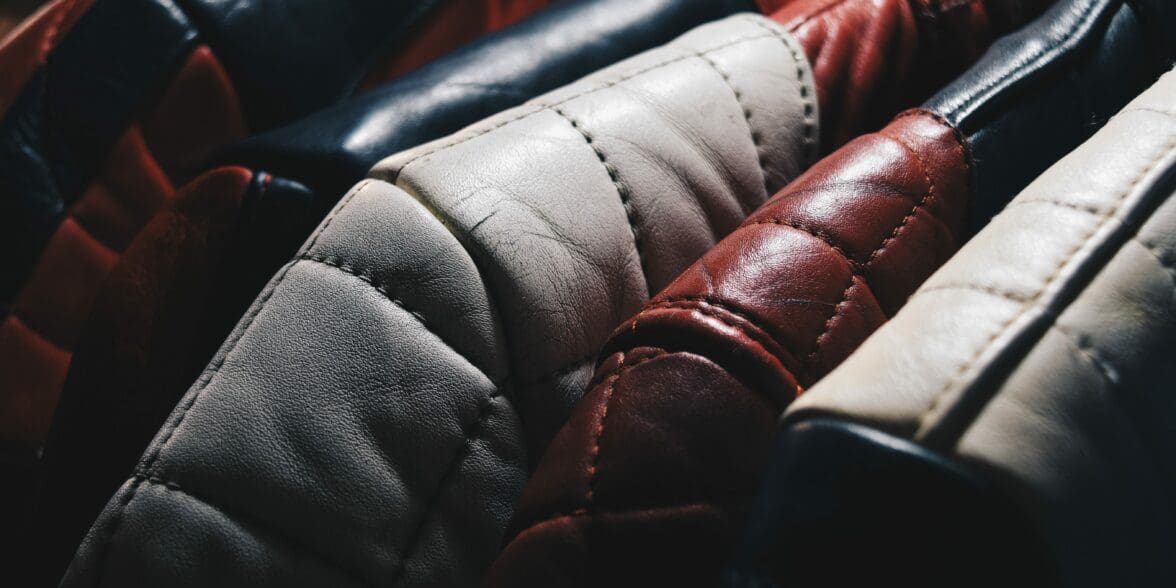CE “Certified” vs. “Approved”? There Is a Difference. We Explain “Tested, Certified & Approved” And What It Means to You As A Rider.
Motorcyclists of the world: you’ve been had. That means me too, and I don’t like it one bit. We strive to bring you precisely accurate information on webBikeWorld. That is information for intelligent people to make intelligent, logical decisions on what to buy. In the rare instance when I — as the Owner, Publisher and Editor — discover a mistake or omission…well, let’s just say it makes me very upset.
In a series of email discussions with Covec, Ltd. and Bull-it staff during our recent review of the Bull-it SR6 jeans, I learned that many of the motorcycle clothing manufacturers have been playing with words, making us believe something that isn’t. I’m referring to the European motorcycle clothing safety standards — the only thing we as motorcyclists can count on for even a smidgen of an idea on whether or not our clothing is actually going to do anything to protect us.
So we put together this informational document (see the webBikeWorld article “Motorcycle Clothing Safety Standards” for more) to try and explain the issues. Many thanks to Keith Bloxsome from Bull-it and Reinder Wondaal from Covec, who provided much of this information and some of the graphics.
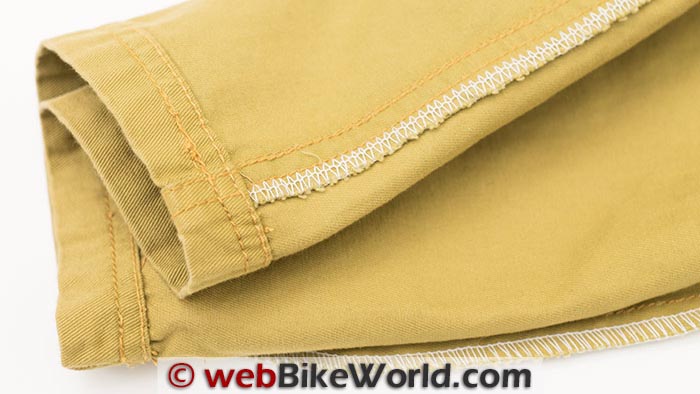
Tested, Certified or Approved?
First of all, it’s important to note that there is a difference between the terms “CE Certified” and “CE Approved”. Too many manufacturers (and you too, distributors and retailers) toss those terms out hoping, as I’ve learned, that we won’t look too far under the covers.
Manufacturers sometimes state something like “tested to meet CE Level 1”. That doesn’t necessarily mean the garment was tested in an approved testing facility. or “CE Certified” or “CE Approved”, when the only part of the garment that might have been tested, certified or approved is the protectors. This is also false: just having certified or approved protectors doesn’t necessarily mean the rest of the garment meets the standards.
Tested: Usually means that the manufacturer tested the garment sample or samples in their own facility to meet (possibly) certain standards. But the sample may not have been sent to a certified testing facility for the official testing procedures.
Certified: Garment samples were tested at a certified testing facility and may have passed specific tests in one or more zones.
Approved: To be “CE Approved”, multiple samples of the garment must have been tested by a certified facility and certified to meet or exceed the relevant standards in all zones.
To repeat, here are the cautions: “Tested” usually means the garment was tested in the manufacturer’s facility and may not mean the entire garment was tested in each zone. Also, you have to depend on the truthfulness of the manufacturer’s claims that the garment was indeed tested according to the specific regimen outlined in the standard.
For “Certified”, it’s important to know which part or zone of the garment was certified. Also, look for the official documentation from the certified lab. Here is a sample entry from an official report. Note also that multiple samples must be tested for an average.
More Subterfuge
Be very careful when reading a manufacturer’s testing claims. Here’s a real example; this happens all the time:
Example: A manufacturer of motorcycle pants claims 5.5 seconds of abrasion resistance. What they don’t tell you is that result was for one version of their pants only, and then only in one zone. Or, they’ll claim a specific performance for all of the versions of a particular jacket or pants, not telling you that the test result was for one model that had different fabrics. Call it what it is: lying! And it happens much too often.
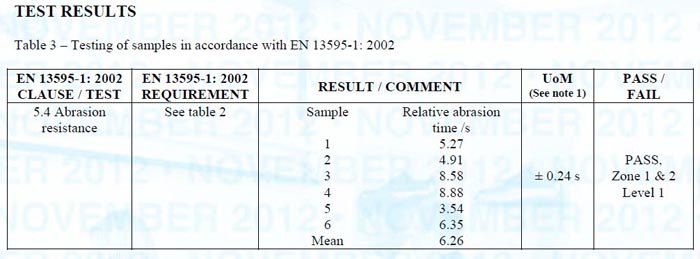
If the garment really is CE “Approved”, then it should have all of the relevant documentation to back up that claim (although the consumer will usually not get a copy of the full official report). Here is a sample .pdf report that illustrates the EN 13595-1 testing regime. The manufacturer and the testing results have been redacted.
And Watch Out for Fakes
We have ranted about the fake CE certifications many times and that’s bad enough. But it’s usually pretty easy to see through those lies. If you don’t get the consumer version of the CE documentation with test results that lists the certifying, approved laboratory and the test results, then your CE “Approved” clothing isn’t.
This frequently happens with protectors included in motorcycle jackets and pants. The manufacturer molds a fake “CE” logo on the protector and tell you it’s “CE Approved”. No documentation? Don’t believe it.
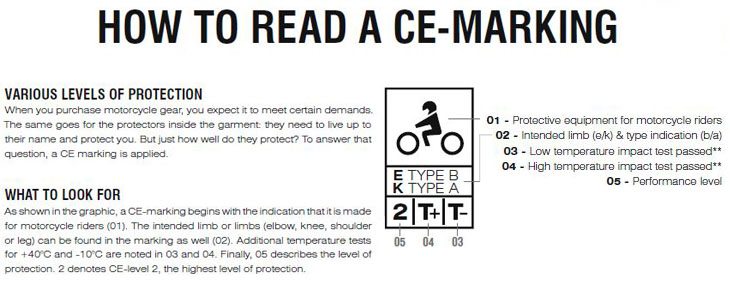
Know the Zones!
To achieve a genuine CE Approval, the garment construction as well as the materials have to achieve the performance levels outlined in the standard, including abrasion resistance, cut resistance and burst strength, in multiple zones.
Meeting all the standards will probably make the garment much heavier; for example, a pair of jeans that is truly approved could be as much as 0.5 kg heavier than non-approved jeans. But you will also be assured that it is certified to have passed all the relevant tests.
And there’s more: as noted, the manufacturer will sometimes state that the garment “meets”, “was tested to”, “certified” or “approved” to, say, the CE EN 13595-1 Level 1 standard. But the garment may have only passed the test in one zone.
If, for example, zone 4 passes with an abrasion resistance of only one second, the manufacturer may mislead you by stating the the garment “meets” or is “certified” to Level 1. But this would be highly misleading, as it only applies to Zone 4 and does not mean that garment meets the full CE test.
A pass for Zone 4 is relatively meaningless for the risks faced across the remaining majority of the garment, as Zone 4 areas are those least likely to be in contact with the road when you crash. See the following:
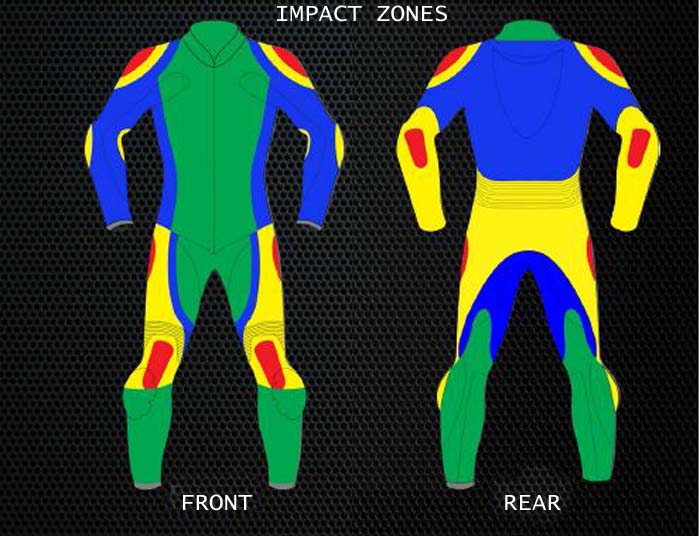
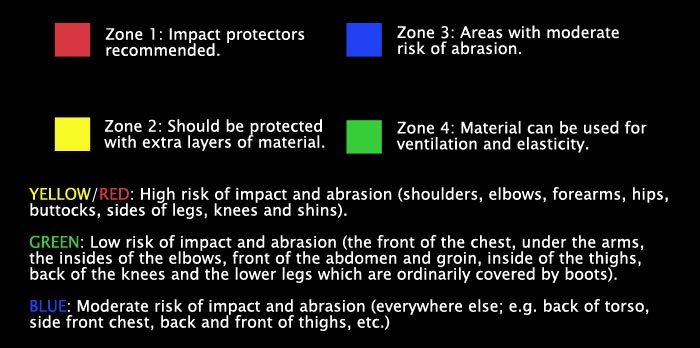
CE Standards for Motorcycle Clothing
Here are the relevant CE standards for Personal Protective Equipment related to motorcycle clothing. NOTE: It’s nearly impossible to find actual copies online of the relevant standards — another pet peeve. Taxpayer money is used to develop the standards, then for-profit companies sell the standards documents back to the public. Standards should be free and open so that anyone who wants to manufacture a better, safer product can have the standards available.
If you know of an online source to download free and full copies of the standards, please contact editor@webbikeworld.com
- EN 13634:2011 (formerly EN 13634:2002) – Protective footwear for professional motorcycle riders. Requirements and test methods. Superseded by .
- EN 13594:2008 – Protective gloves for professional motorcycle riders. Requirements and test methods.
- EN 1621-1:1998 – Motorcyclists’ protective clothing against mechanical impact. Requirements and test methods for impact protectors.
- EN 1621-2:2003 – Motorcyclists’ protective clothing against mechanical impact. Motorcyclists back protectors. Requirements and test methods.
- EN 1938:1999 – Personal eye protection. Goggles for motorcycle and moped users.
- EN 13595-1:2008 – Protective clothing for professional motorcycle riders. Jackets, trousers and one piece or divided suits.
- EN 13595-2:2002 (2008) – Protective clothing for professional motorcycle riders. Jackets, trousers and one piece or divided suits. Test method for determination of impact abrasion resistance.
- EN 13595-3:2002 – Protective clothing for professional motorcycle riders. Jackets, trousers and one piece or divided suits. Test method for determination of burst strength.
- EN 13595-4:2002 – Protective clothing for professional motorcycle riders. Jackets, trousers and one piece or divided suits. Test methods for the determination of impact cut resistance.
For abrasion resistance (EN 13595-1), Clause 5.4 is relevant. Cut resistance (EN 13595-1), Clause 5.5. For burst strength (EN 13595-1), Clause 5.6 is relevant. The combined report for full CE approval is all of EN 13595-1 (currently :2002).
Also, CE 13595-2 is the same as CE-13595-1, Clause 5.4. CE-13595-1 when used on its own means all the tests combined. For example, CE 13595-1 means 13595-2, 13595-3 and 13595-4 together. CE 13595-1 clauses 5.4, 5.5 or 5.6 identify each section of the test: Impact, Cut and Burst.
What to Look For
- Does the manufacturer list a CE zone diagram and explain exactly how the clothing item was tested, certified or approved?
- Do they explain the meaning of the times they recorded for the Level 1 and/or Level 2 tests?
- Do they explain that certified means tested but not Approved?
- Do they provide the necessary documentation listing the certified testing facility and the test results?
If a manufacturer claims that a jacket, pants, jeans, gloves or helmet is “CE Approved”, ask to see the proof. Tell ’em no proof, no sale! We can force this issue and get them to change.
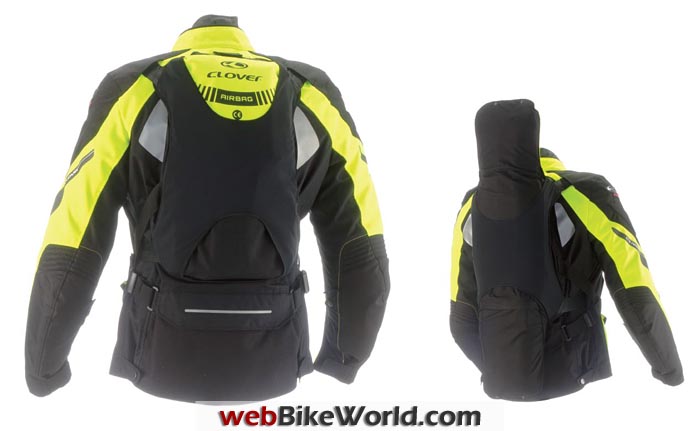
The EN 13595-1:2002 Standard in France
EN 13595 -1 2002 for motorbikes garments or French protocol harmonized protocol according to standard EN 13595-1 2002
requires exactly the same impact abrasion test in zone 2 and 3.
Here is a .pdf copy of “Protocole Pour L’Évalution de la Confirmité a la Directive 89/686/CEE des Vêtements de Protection Pour Motocyclistes Non-Professionnels” (The Protocol for Evaluation of Conformity to the Directive 89/686 EEC of Protective Clothing for Non-Professional Motorcyclists).
The EN 13595-1:2002 standard for motorbike garments or the French harmonized protocol according to standard EN 13595-1:2002 requires exactly the same tear strength test in zone 2 and 3. Only the level of performance changes; lower for the French Protocol because the value of the original European Standard were very difficult to reach, especially for textile.
The value to reach with the original European EN 13595-1:2002 standard is a force of 100 Newton(for leather and textile materials). The value to reach with French protocol harmonized protocol according to standard EN 13595-1 2002 is 50 Newton (for leather and textile materials). This is lower and therefore more easily attained.
The tear strength test for motorbikes garments is for the upper material. There is also a tear strength test for Footwear: it is EN 13634-1:2011, but it is only for lining textile material. It is the same method but value are adapted for textile footwear lining and not transposable to upper garment materials.
So, for textile garments and leather material, the recommendations are using the impact abrasion test of the French harmonized protocol according to standard EN 13595-1:2002 and the tear strength test of the French harmonized protocol according to standard EN 13595-1:2002.
The Future of CE Standards
[Editor’s Note: While discussing these issues with other European-based motorcycle clothing manufacturers, I received this information from the Director of Product Development for a very well-known and very large manufacturer of motorcycle clothing who wishes to remain anonymous.It is very interesting and points to perhaps a future resolution of these issues, although it could also be argued that street riders need just as much (or more) protection than “professionals”.]
“Someone told me you had an interesting article about CE standards on webBikeWorld, so naturally I read it.
Just to give you some background: currently, various European apparel manufacturers are talking to set up a new standard for “protective clothing for motorcyclists for urban and leisure use”, a lighter version of the standard EN 13595-1:2002 to 13595-4:2002.
The main reason is that the French government has stated that not only motorcycle apparel for professional use should comply to the relevant standards (including the footwear and gloves standards), but also apparel for leisure and urban use.
The French government simply state that if a product is promoted or even implies that it is ‘protective’, it should be regarded as PPE (Personal protective Equipment) and should therefore comply to the standards, regardless if it is intended for professional use or not. They surely have a point there! We agree that it is in our joint interest as an industry to determine minimum standards when claiming to produce safety apparel.
And also that it is our moral duty as a serious developer of safety apparel to inform the final consumer correctly as to the level of protection he or she might expect when buying a garment described fit for motorcycle use. The problem at this point is that the standards as currently in place are for professional use. So we’re not talking about motorcycle apparel for leisure or urban use. As a result, nobody has ever been busy with it. The only standards that are also applicable to leisure and urban use are related to back protectors and limb impact protectors.
(Regarding back protectors; recently a revised norm for back protectors was made applicable, the EN 1621-2:2012 (more stringent norms also considering the impact values when hot, cold and wet)).
The standards for professional use are generally deemed to be too rigid and unrealistic by practically all manufacturers and we agree. In 2013, only Clover was offering CE Level 2 certified and approved apparel (see the webBikeWorld Clover Tekno jacket review).
To acquire certification and approval, the product needs to be tested and approved by a certified body and you’re then talking about jackets that cost around $1,000.00 USD in retail. They are great products but (necessarily) over-engineered to meet the stringent EN13959-1 through 4 (:2002) standards with the result of not being really suitable for most recreational or urban riders. Passive safety predominantly lies in comfort (weight, freedom of movement, climate control) and visibility and this is disregarded or simply not addressed by the current standards.
Forced by their own government, some French brands have united and have come up with their own ‘light’ version of EN 13595 1-4 (jackets, trousers and suits) and EN13594 (gloves) which are called Protocol VO5 and VO6 (they label it as CE Level 1; see Bering, Ixon and Furygan’s collections for example).
The French government has ‘approved’ this and they now have been trying to make this compulsory in the EU.
We and most other non-French brands (i.e. Alpinestars, Dainese, REV’IT!, Spidi) disagree with this concept and have proposed (through ACEM (the EU equivalent of your Motorcycle Industry Council) and WG9 (the EU governmental work group related to PPE) to jointly develop a new standard for urban and leisure use.
As far as we are concerned, the standard for professional use can stay intact. A representative of our Product Management team is represented in that discussion group.
Basically, it is all about consumer protection: the consumer has the right to know exactly what he or she buys. This includes the right to know what to expect from a product when it is sold as Personal Protective Equipment. It is currently unclear and simply a mess, even for the very professional companies mentioned above.
We agree that:
- There should be a new standard, set up like the EN 13595 standard for professional use, for urban and leisure use. A ‘lighter version’ with lower requirements, but at least minimum requirements related to [1,] impact abrasion resistance, [2.] burst strength and [3.] impact cut resistance.
- It should be clearly marked on the outside of the product to what level of protection (professional or leisure/urban use standards) the product complies to. This is important information for the consumer.
- It should be clearly explained in the documentation provided with the product.
- The products (in our opinion) should not have to undergo a certification process by a notified body as this is a very costly and time (more costly) consuming procedure. However, the EU equivalent of the food and drug authority should control this stringently and penalties should be very high when, after random samples are inspected in the lab, the claimed level of protection is not being met.
- There should also be high penalties for all manufacturers who bring products on the market with fake CE labels. In that sense, it would be great if the EU government would in some way control the quality and supply of CE labels (something with fraud protection built in) that can be attached to a product.All producers would then have to apply for these labels (which can even have a unique code/number) and it will also provide great insight in actual sales volumes of motorcycle apparel in the European Community (we can’t sell more than the number of labels being issued).It would be a nice side effect to have this data to also be able to estimate your market share.
- All current documentation should be refreshed/updated and one single document should be created by ACEM that clearly states what we and our fellow producers should adhere to. Also, for non-EU manufacturers, it should be clear what to adhere to if they want to sell PPE in the EU.Maybe this information is linked to the EU government issued CE labels (I mean that the compulsory explanation of the standard the product adheres to for the consumer, is written in a booklet that has the fraud protected CE-label on the front). Just my opinion for the moment.”
UPDATE on Future CE Standards
(January 2016) Here’s an update on the so-called revised CE standards, based on a conversation with a person on the CE board.
It is believed by many on the CE board that the current standard makes it too difficult to mass produce clothing by some of the manufacturers. Some of the manufacturers say that it is currently ‘too difficult to achieve’; e.g., commercially too difficult to manufacturer in quantities or ads too much cost and also makes clothing too restrictive for the rider.
Thus, the CE board is currently looking at ways to implement a workable standard for quality and safety control on all clothing for a more widely used standard so that more manufacturers will actually meet the standards rather than produce clothing without testing to a standard.
Having a standard that more people can adhere to may, in the long run, be better for the rider. If and when another standard is legislated, it would have performance parameters similar to what we do now. Then, a motorcycle rider can still then make a ‘performance choice’ rather than a fashion choice. It is widely believed that any implementation of a new standard would take at least another 2 years. The current debate is about 2 or 3 different test methods. So there is currently no conclusion or date on when or if this might happen. The standards currently used are the only one (or two counting the French measurement chart version) and there is a conversation being held to determine which test and what levels. So any online articles about standards changes are pure rumour at this point, as no outcome has been determined to date.
Recent articles that claim that a new standard will result in weaker clothing or test methods may actually be a strategy for trying to sell more clothing under the current standards because riders will fear that a new standard will be weaker.
In other words, some people may think that it is easier to say that any upcoming test is not relevant or dated and further confuse the market than spend the money to improve the market space.
See Also: Motorcycle Clothing Safety Standards and DOT vs. ECE Helmet Safety Standards as well as all our motorcycle safety related articles.
Reader Comments and Feedback
From “B.G.” (April 2015): “I’m so pleased to have access to, and now understanding of, the issues surrounding the PPE wording applied to garments by the garment manufacturers. I had no idea it is so complex an issue, with no clear cut meaning and intent. i.e.: obfuscation at every turn. I am also encouraged regarding the ‘future’ part of the article. In this manner, the EU provides the needed worldwide leadership position, and I am thankful to them for ‘stepping up to the plate’. Thank you so much for helping us survive our sport!
I read carefully the proposed rules regarding the ‘relaxed’, or ‘light’ standards as applied to the leisure / urban use. I’m OK with most of it. All except that ‘self policing’ / ‘self certifying’, with random unannounced enforcement, to control certification testing costs. This method has not successfully deployed for any other product that I’m aware of. Please indicate a product where this enforcement method actually works, I would like to be proven wrong here. I humbly request that another method be discussed and chosen.
My opinion is, in this case, manufacturers will accept the ‘hand slap’ monetary fine, make a minor change to satisfy the policing authority, and go on with ‘business as usual’. A cynical opinion, I know, but one arrived at by looking at too many every day examples. All in all, a great eye-opening article, and encouraging in its look at future developments for our protective equipment. Just please arrive at a better enforcement, one with ‘teeth’.”
From “B.R.” (March 2015): “Your article on the abuse of the CE standards was very informative. Thank you for exposing the soft underbelly of motorcycle garment manufacturers world wide. Most motorcycle clothing manufacturers offerings are a shameless sham that endangers the riding public with the false hope of even adequate protection. I have thought this for years after having witnessed the shredding of many a fine over priced and over hyped jacket, pant and human being in even the most minor of accidents. Congratulations on a job well done!”
From “D.W.” (March 2015): “Great article. Candidly, I am surprised that there have not been enterprising young lawyers who latch onto the apparent misrepresentations by manufacturers and sue them based on an injured client (or class action). I am not a big fan of personal injury attorneys, but it is one way to drive change. Generally, it makes the products much more expensive, so I hope the manufacturers get their acts together and start advertising what protection their products truly provide.”
From “H.S.” (March 2015): “This is a great article, and served to confuse me even more, which is probably what manufacturers are hoping for:):) Here is what Spidi says about the excellent Ergo Pro. I have and love this jacket. I’ll be bummed if it is not actually approved, based on your article. I’d like your take on it if you don’t mind?”
Rick’s Reply: Wow, a manufacturer actually showing the test results! Actually, some claimed CE-approved textile jackets are becoming available, following Clover’s 2013 lead. This one looks pretty good their documentation looks correct, so I guess you’d have to believe them. We should start a list here of manufacturers and gear that really does meet the standards. If anyone has another link — with proof — let’s get it posted!
From “J.L.” (March 2015): “Very interesting, thanks. So, for the system to really work, there should be some sort of central database listing approved garments, IMHO.
I agree with you about the cost of standards (in my profession, I very often need to refer to standards in one way or another), but I’m note sure that « public money » is used to develop them. Usually, they are developed by independent organizations which don’t receive any public money, I think. Side note: is there a chance to see (pun intended) on wBW a button to increase type size?? Thanks in advance.”
Rick’s Reply: I’m working on revising the page but with nearly 16 years and 4,000+ pages, it’s pretty hard to bring everything up to modern specifications. Back when I started, there were really no smartphones, no tablets! Not sure which browser you use, but most have quick buttons to increase font size. Chrome and Firefox, do a Ctrl + (or – to decrease), it’s easy.


